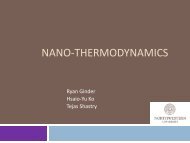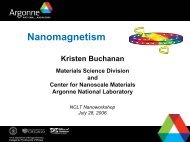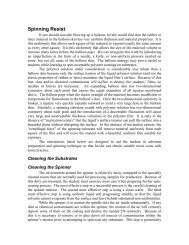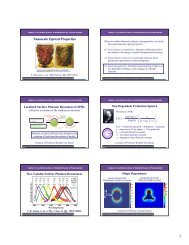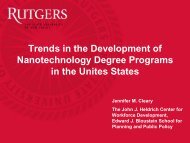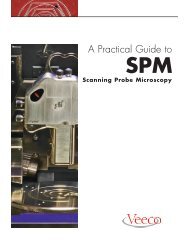Changing Surface Area and Volume with Changing Shape - NCLT
Changing Surface Area and Volume with Changing Shape - NCLT
Changing Surface Area and Volume with Changing Shape - NCLT
You also want an ePaper? Increase the reach of your titles
YUMPU automatically turns print PDFs into web optimized ePapers that Google loves.
Sample Student Activity<br />
<strong>Changing</strong> <strong>Surface</strong> <strong>Area</strong> <strong>and</strong> <strong>Volume</strong><br />
<strong>with</strong> <strong>Changing</strong> <strong>Shape</strong><br />
When you are cold <strong>and</strong> not in a position to put on more clothes, you keep<br />
your arms close to the rest of your body. If you were really cold, you may sit<br />
hugging your knees to your chin. Most l<strong>and</strong> mammals, lizards, <strong>and</strong> snakes<br />
"curl up" to make their bodies as compact as possible in a cold environment.<br />
Bears, for example, can become almost spherical. Conversely, when animals<br />
are hot, they tend to stretch out.<br />
An individual animal can control its shape-up to a point. That point is<br />
determined by the animal's anatomy. In ecology, there is an anatomical<br />
rule-of-thumb, or general guideline, called Bergmann's Rule. It applies to<br />
"warm-blooded" animal species that have populations that live in both warm<br />
climates <strong>and</strong> cold climates. It simply states that there is an inverse<br />
relationship between average ambient temperature <strong>and</strong> animal size.<br />
Examples of mammals include white-tailed deer, which are larger in Canada<br />
than in the Florida Keys. The common wolf is 20% larger in northern<br />
Canada than in northern Mexico. At latitudes greater than 30 o , both south<br />
<strong>and</strong> north, mountain lions are larger than those closer to the equator. Flying<br />
squirrels in the Arctic are more than 50% larger than those in Central<br />
America. The smaller species have a proportionally larger surface area per<br />
unit volume compared to their larger counterparts. Therefore, the smaller<br />
animal has exterior surface for the same volume available to dissipate heat<br />
in the warmer climates.<br />
Scientists have discovered that this kind of surface effects also has a<br />
dramatic impact on nanoscale materials when they become so small. The<br />
melting point of substances is normally a constant characteristic (as long as<br />
pressure is kept constant). In fact, it can be used to identify substances. In<br />
Shown at the same scale: Emperor<br />
penguins (left) in Antarctica are bigger<br />
than Fairy penguins (right) in Australia<br />
<strong>and</strong> New Zeal<strong>and</strong>.<br />
metals, however, scientists have observed large decreases in melting points as the size of metal particles<br />
decreases in the nanoscale. The melting point for gold that we can hold in our h<strong>and</strong>s is 1064 o C. If this piece of<br />
gold is broken into smaller <strong>and</strong> smaller pieces, the melting point of each is still 1064 o C—until the pieces get<br />
smaller than 1 µm. Then the melting point starts to decrease, very little at first. It is not until the gold particle<br />
gets to 20 nm that the melting point really drops, when the amount of surface area per unit volume increases by<br />
a million times. It has been measured for particles as small as 2 nm to be 350 o C, <strong>and</strong> by extrapolation, it would<br />
be 200 o at 1 nm. Another property change that is related to increase in surface area is chemical reactivity. The<br />
surface area per volume increase due to the nano-size of the catalytic materials <strong>with</strong>in the catalytic converter<br />
volume of 1000 - 2000 cm 3 is impressive: it is the area of about 10 football fields!<br />
Size is an ambiguous word, although we generally underst<strong>and</strong> it to mean volume. This activity deals <strong>with</strong> the<br />
quantities: surface area <strong>and</strong> volume. As an object decreases in size, obviously its volume (V) decreases, <strong>and</strong> so<br />
does its surface area (SA), but not at the same rate. A major reason that the nanoscale is special involves the<br />
scaling down of the surface area to volume ratio: SVR. You will explore this ratio for geometric objects.<br />
Try This<br />
You will need: 32 identical sticks <strong>and</strong> 27 linking cubes.<br />
Page | 1
Sample Student Activity<br />
A. Ideal 2-D Objects<br />
___1. Make predications: 1) Sketch a rectangle that you think has the smallest possible ratio of perimeter to<br />
area (P/A). 2) Sketch a rectangle that has about the same A as the rectangle you sketched in step 1, but<br />
has a larger ratio of P/A.<br />
___2. Obtain 32 sticks. Divide the sticks into 4 groups of 8 sticks. You will make four polygons, as described<br />
below. For each polygon, use one group of sticks, making sure to use all 8 sticks.<br />
a) a rectangle <strong>with</strong> the minimum perimeter to area ratio (P/A)<br />
b) a rectangle <strong>with</strong> the maximum P/A<br />
c) a polygon <strong>with</strong> the minimum P/A<br />
d) a polygon <strong>with</strong> the maximum P/A<br />
___3. Sketch each of the four polygons you made. Discuss <strong>with</strong> your teacher which measurement units to use.<br />
B. Properties of 3-D Objects<br />
___1. Make a predication: Read steps 1 <strong>and</strong> 2 of the Procedure below. Predict a<br />
shape for the minimum <strong>and</strong> the maximum ratios of surface area to<br />
volume (SVR).<br />
___2. Each group should obtain at least 24 linking cubes. Divide the linking<br />
cubes into 3 groups of 8 linking cubes. You will make two or three<br />
shapes, as described below. For each shape, use one group of linking<br />
cubes, making sure to use all 8.<br />
a) Make a shape <strong>with</strong> the minimum SVR.<br />
b) Make a shape <strong>with</strong> the maximum SVR.<br />
Is there a different shape <strong>with</strong> the same maximum SA/V? If so, create it.<br />
___3. Record a description of each shape. Don't forget units for SA <strong>and</strong> V.<br />
___4. Consider SVR for the two cubes illustrated on the right. Which do you think has a<br />
larger SVR? Make a prediction. 2) Imagine more cubes of different sizes. Predict<br />
the shape of a graph of SA vs. L (the length of an edge) <strong>and</strong> SVR vs. L<br />
for the cubes. Sketch your predicted graph.<br />
___5. Create more cubes to explore the relationships between<br />
V vs. L, SA vs. L, SVR vs. L, SVR vs. 1/L.<br />
Before making the cubes, predict the shape of the graph for each of<br />
these relationships.<br />
Questions<br />
1. How did your results compare <strong>with</strong> your predictions? Were any of the results unexpected? Explain.<br />
2. Consider how you could make P/A for a rectangle larger <strong>and</strong> larger. What is the limit?<br />
3. Which (SA or V) increases faster <strong>with</strong> L? How do you know?<br />
5. If you had obtained data for the same variables but for a different shape, let's say a sphere rather than a<br />
cube, how would the graphs differ?<br />
4. For the SVR vs. L graph, is there a minimum ratio of SA to V? Is there a maximum ratio of SA to V?<br />
6. The graph created SVR vs. L leaves something to be desired <strong>with</strong> respect to illustrating the geometric<br />
relationship for very small L. Create a log-log graph of the data.<br />
7. A sucrose molecule has L ~ 0.4 nm. For the SVR vs. L graph you created, indicate approximately where a<br />
sucrose molecule should be plotted.<br />
Information from the World Wide Web<br />
1. An interactive cube building simulation for creating larger block of cube is available at the National Center for<br />
Learning <strong>and</strong> Teaching (<strong>NCLT</strong>) in Nanoscale Science <strong>and</strong> Engineering’s NanoEd Resource Portal://nanoed.org<br />
Page | 2



